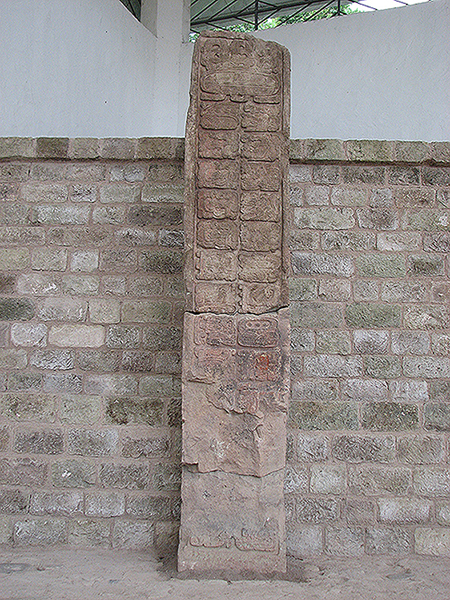Stela 63
Location: Papagayo Structure, 10L-26
Dates: 9.0.0.0.0 8 Ajaw 14 Kej / December 9, 435 CE
Rulers: 1, 2, 4
Photo Courtesy of Dr. Clark Erickson
Stela 63 was erected by Popol Hol to celebrate his father Yax K’uk’ Mo’s witness of the bak’tun ending on 9.0.0.0.0 8 Ajaw 14 Kej, or December 9, 435 (Fash 2011, 105; Fash, Fash, and Davis-Salazar, 76). The stela was found in the Papagayo structure in 10L-26. This structure had replaced the previous Motmot level which had housed the aptly named Motmot marker. This marker had also commemorated the bak’tun ending and had placed the father and son together, so this stela may have been considered a replacement monument for the marker. The stela in fact would remain visible until the thirteenth ruler Waxaklajuun Ubaah K’awiil built over the structure (Fash, Fash, and Davis-Salazar 2004, 78; Martin and Grube 2008, 202) Even after this portion of the building was destroyed, Stela J would take Stela 63’s place as the 9.0.0.0.0 b’aktun marker, emphasizing both the importance of the date and of Yax K’uk’ Mo’ (Fash, Fash, and Davis-Salazar 2004, 78).
The stela itself is classified as a Type VII Copan stela with three carved sides composed entirely of glyphs. Interestingly, no other Copan stela is listed in this category (Fash 2004, 259). No more figural stelae would be erected until Moon Jaguar’s reign in 554 (Fash 2004, 255). The fourth side of the stela was blank, as the monument stood against the back wall, where a large crocodilian monster was depicted to represent the surface of the earth (Fash 2011, 105). The base of the sculpture would later be found in place against this wall, with the stela ritually destroyed. The macaw heads from the ballcourt would be found among the fragments likely as a tribute to the Founder (Stuart et al. 1989, 1).
The last glyph of the text names Yax K’uk’ Mo’ followed by what is believed to be Uxwitza’ ch’ajoom, or “Three Hills Water Lord.” The title “Three Hills Water” is associated with the Maya Lowland city of Caracol, leading David Stuart to believe that this is where the Founder originated. Thirteenth king Waxaklajuun Ubaah K’awiil similarly referred to the Founder as “Three Hills Lord” in Stela J«/a> over 250 years later, and before him, seventh king Bahlam Nehn was mentioned by name on a Caracol Stela (Stuart 2007). By invoking this title, Popol Hol may have been appealing to the Founder’s Lowland Maya origins.
When fourth ruler K’altuun Hix later renovated the structure, he would add a step and a bench to the stela, blocking some of the text (Fash, Fash, and Davis-Salazar 2004, 76-77). Interestingly, the text on the stair would invoke the second person, which was rare in Maya monuments (Martin and Grube 2008, 196). K’altuun Hix would refer to “your gods” and “your land”, speaking to both the stela’s text and perhaps also the Founder himself. The structure did have some references to Teotihuacan in its inclusion of the feathered serpent and green obsidian, and the stair itself did have the glyph puh or bulrush which would later be found in the final version of 10L-26 specifically to invoke the ancient city (Fash 2011, 105; Fash, Fash, and Davis-Salazar, 78). The fourth king’s use of the second person may indicate a sense of separation, perhaps in following more local styles and deities. While Teotihuacan would continue to influence monumental sculpture, this style would reach its peak prominence after the city had fallen towards the latter half of the Classic Copan lineage (Fash 2004, 261). Little is known about K’altuun Hix’s rule to explain his motivations.
Motifs:
- Bulrush
See Also:
- 10L-16
- 10L-26
- First Ballcourt
- Motmot Marker
- Caracol Stela 16
- Stela J
Sources:
- Fash, Barbara W. 2011. Copan Sculpture Museum, The. Cambridge: Peabody Museum Press.
- Fash, William L., Barbara W. Fash, and Karla L. Davis-Salazar. 2004. "Setting the Stage: Origins of the Hieroglyphic Stairway on the Great Period Ending." In Understanding Early Copan, edited by Ellen E. Bell, Marcello A. Canuto, & Robert J. Sharer, 65-84. Philadelphia: University of Pennsylvania Museum of Archaeology and Anthropology
- Martin, Simon and Nikolai Grube. 2008. Chronicle of the Maya Kings and Queens: Dynasties of the Ancient Maya. London: Thames and Hudson
- Stuart, David. 2007. "The Origin of Copan’s Founder" Maya Decipherment: Ideas on Ancient Maya Writing and Iconography website, June 25. Accessed April 21, 2020. https://mayadecipherment.com/2007/06/25/the-origin-of-copans-founder/
- Stuart, David, Nikolai Grube, Linda Schele, and Floyd Lounsbury. 1989. “Copan Note 56: Stela 63, A New Monument from Copan”. In The Copan Notes, 1-8. Austin, TX: Copan Mosaic Project
